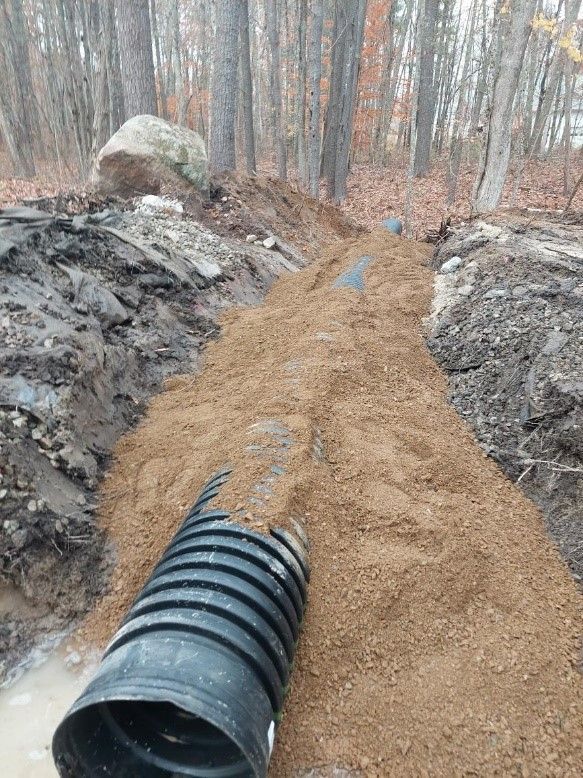Accuracy Pad Construction for Stable Structures
Accuracy Pad Construction for Stable Structures
Blog Article
Culvert Installment Facilitated: Step-by-Step Overview for Success
Installing culverts may seem like a simple job, but making sure a successful outcome calls for mindful planning and implementation. From choosing the suitable culvert size to incorporating appropriate water drainage measures, each action in the installation procedure plays an essential function in the capability and longevity of the culvert system. By following a systematic method and taking notice of vital details, the installation can continue smoothly, reducing possible problems down the line. Keep tuned to discover the necessary steps and considerations that can make culvert setup a seamless and successful undertaking.
Choosing the Right Culvert Size
Choosing the appropriate culvert size is crucial for making sure reliable water flow and structural stability in culvert setup projects - Pad Construction. The size of the culvert directly impacts the circulation capacity of water via the structure. A culvert that is as well tiny can cause flooding and overflow, while one that is also large may cause reduced water rate, possibly creating debris buildup and blockages
To identify the ideal culvert size, elements such as the watershed location, top flow rates, and hydraulic effectiveness demand to be very carefully thought about. Calculations based on these criteria assist in choosing a size that can sufficiently deal with the expected water volume while reducing the danger of clogs and structural failure.
It is necessary to consult engineering guidelines and standards to make certain that the selected culvert size satisfies the project needs and neighborhood guidelines (Pad Construction). By picking the right culvert size, project supervisors can optimize water circulation, protect against prospective concerns, and boost the general performance and long life of the culvert installment
Preparing the Setup Website
Reliable culvert installment demands thorough preparation of the installment site to make sure optimum architectural assistance and functionality. Before starting the setup procedure, it is important to clear the website of any particles, vegetation, or obstructions that might impede the culvert's positioning.
Additionally, it is necessary to think about aspects such as dirt composition, groundwater levels, and environmental influences when preparing the setup website. Carrying out a comprehensive site assessment can aid determine any type of potential difficulties or risks that may affect the culvert's efficiency. By putting in the time to prepare the installation website correctly, you can assist ensure a successful culvert setup that meets architectural requirements and ensures lasting capability.
Positioning the Culvert Correctly

The grade at which the culvert is put is important for keeping a proper slope for water flow. A progressive incline aids stop merging and promotes reliable water drainage. Additionally, the culvert needs to be oriented appropriately to make sure that the inlet and electrical outlet remain in the correct areas. This orientation is essential for the culvert to operate properly in handling water circulation.
Backfilling and Condensing the Soil
Correct backfilling and compaction of the dirt around the culvert is important to make sure security and avoid prospective problems in the future. Once the culvert is properly positioned, the next important action is to backfill the area around it with ideal product. The backfill material must be without rocks, debris, and raw material to avoid damage to the culvert. It is advised to utilize granular material such as sand or gravel for backfilling, as it gives great drainage and compaction residential or commercial properties.
After positioning the backfill material, it is essential to portable it in layers of uniform thickness. Making use of a compactor or a mechanical tamper, small the dirt delicately to prevent damaging the culvert. Compaction helps in minimizing the possibilities of negotiation and ensures consistent assistance around the culvert. It is vital to compact the soil equally on all sides of the culvert to preserve its structural honesty.
Appropriate backfilling and compaction not just give security to the culvert however additionally assist Underbrush Clearing in avoiding dirt disintegration and maintaining the longevity of the culvert system.
Ensuring Proper Drainage Combination
Incorporating reliable drain solutions plays a critical role in the general capability and long life of culvert installations. Correct water drainage assimilation is important for taking care of water circulation, avoiding disintegration, and ensuring the architectural integrity of the culvert system. To accomplish this, it is essential to develop a detailed drain plan that considers variables such as the volume of water expected, the topography of the location, and the sort of dirt present.

In addition, integrating features like erosion control actions, such as riprap or greenery, can even more improve the effectiveness of the drain system. By meticulously intending and carrying out these drain solutions, culvert installations can work effectively and hold up against the examination of time.
Verdict
To conclude, correct culvert installment is crucial for keeping efficient water drainage systems. By choosing the ideal culvert dimension, preparing the installment site, putting the culvert appropriately, backfilling and condensing the soil, and guaranteeing correct drain combination, success can be attained. Complying with these steps will assist make sure the durability and efficiency of the culvert, ultimately adding to the overall success of the water drainage system.
Report this page